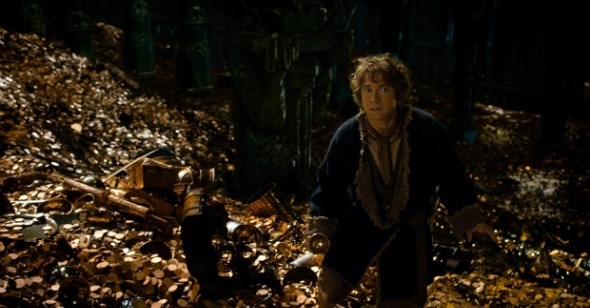Back to the Middle
By Tyson Kubota
The Hobbit: The Desolation of Smaug
Dir. Peter Jackson, U.S., New Line Cinema/MGM/Warner Bros.
Peter Jackson has directed five J. R. R. Tolkien films so far this century. In the end, the movies in that universe will span two trilogies and nearly a full day’s run time.
Last December, nine years after the Lord of the Rings series concluded, Jackson released his first Hobbit film, An Unexpected Journey. With its many longueurs and dim 3D, it left my head swimming with questions: can Peter Jackson’s Middle-earth still hold any interest for him, or for us? What do these new films add to mass culture?
The latest franchise entry, The Desolation of Smaug, helped answer those questions. Whereas the Rings trilogy endeavored mightily to condense an epic narrative, and support it with a detailed fictional world, the Hobbit films find Jackson reversing that balance. The setup—a hobbit and a wizard join a band of dwarves on a quest to seek treasure and slay a dragon—is simple, although loaded with lore and leavened with Jackson’s plot additions, like a romantic interlude featuring the she-elf Tauriel (Evangeline Lilly) and a goblin home invasion straight out of Gremlins. From the decision to split Tolkien’s 300-page children’s novel into three three-hour movies, it was clear that narrative economy was never a priority, but the payoff of this strategy becomes clear in Smaug: this new trilogy is best at luxuriating in its setting, expanding to fill all available space and time.
Cleared of its duty to start or finish the saga, the latest Hobbit begins and ends in medias res, with barely any exposition. This middle film about Middle-earth thus has more opportunity for tactile exploration: of the contrasting textures of the latex-masked orcs and computer-generated goblins, of Ian McKellen’s shaggy fake Gandalf beard and the platinum-blond hairpieces of the Mirkwood elves. It’s loaded with rococo surfaces, studied in a strangely durational fashion.
This can lead to boring stretches, but also satisfyingly meaty action scenes. Consider Bilbo and the dwarves’ escape from an elvish prison, while being pursued by demonic orcs: a dozen dwarves in floating barrels bob among frothing rapids, glimpsed in CG long shot and in first-person crash-cam perspective. Digitally rendered elves dart and leap along the riverbank in pursuit, felling orcs with every step. One squat barrel launches itself out of the water like a cannonball, aimed at the orcs lining the riverside. In a single sixty-second take, the barrel rolls along the bank, bouncing from orc to orc, knocking a dozen enemies into the rapids. The barrel rights itself on the shore with a wobble; a fat dwarf bursts forth, an axe in each hand, and twirls to fell the remaining foes. The audience bursts into applause (at least the one at the Union Square Regal Stadium 14 did).
Smaug is a better movie than its predecessor because it’s more exciting, but also because Jackson has, after a fumble, recovered his talent for matching escapist fare with world building. It shares with its Rings predecessors an explicit thematic focus on brotherhood and discovering individual heroism—some narrative threads revive, and therefore anticipate, Rings’ proto-fellowship of dwarves and elves—and of driving the action by matching sweeping vistas to its characters’ inner states. But unlike the Rings trilogy’s watery moralizing between Frodo and Sam, this story’s emotional center is the witty, steadfast Bilbo (Martin Freeman), who prefers theft and riddles over dolorous looks.
To be sure, this Hobbit refines more than reinvents its predecessor’s formula; both have a surfeit of CG crowd battles and a liberal dose of ridiculousness, and like part one’s Gollum encounter, the best scene in Smaug is a mano-a-mano confrontation between Bilbo and his nemesis. The titular red dragon, replete with gnarled horns and armored scales and imbued with a calculating, vain personality, is a spot-on visualization of Tolkien’s original creature. As Smaug matches wits with Bilbo, Benedict Cumberbatch’s digitally assisted basso profondo rattles the dragon’s caves of gold and the theater rafters both. These isolated encounter scenes, each pairing Bilbo with a special-effects creature, are comparatively rigorous and spare, bulwarks amidst the surrounding sound and fury. They are moments of puncture, but also of synthesis, which point to a more mature style, where Peter Jackson the gleeful gross-out trickster of Bad Taste and The Frighteners meets Peter Jackson, Oscar-winner and multimedia magnate.
In the decade since Lord of the Rings, a smorgasbord of once-marginalized geekiness has overwhelmed mainstream culture. It’s all fair game now: trained Shakespearean actors emote between video-game-inspired digital fisticuffs and GoPro helmet-camera footage. Perhaps above all else, this has been the Rings cycle’s major contribution to mass culture. Its literalist fantasy mode—a flexible mix of practical props and sets with blue-screens and computer graphics—has become the dominant screen language of this new century, a visual vernacular suited for a box office ruled by superhero fantasies. Seen in this light, the title of next year’s conclusion, The Hobbit: There and Back Again, seems just right.
